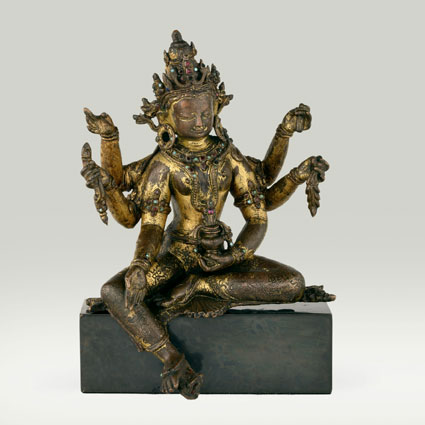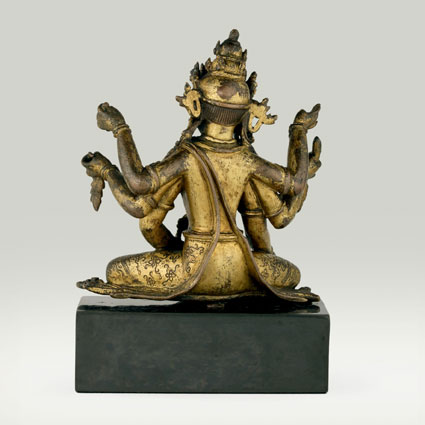
ABS 106
Code: ABS 106
Country: Nepal
Style: Early Malla Period
Date: 1300
Dimensions in cm WxHxD: 13 x 18.4 x 5.8
Materials: Gilt copper; inset with precious stones
The separately cast lotus pedestal is lost.
The ornamentation of the crown and necklace is inset with precious stones and turquoise.
The garment is decorated with floral pattern.
The six-armed goddess, identified as Vasudhara (Tib. Nor rgyun ma), is seated in the attitude of ease (lalitasana) and was originally mounted upon a lotus pedestal. She is clad with a cloth tied around the waist with a belt and a shawl placed over the left shoulder and tied across the chest. The upper right hand displays the buddhasramana- mudra (?) and the upper left hand holds the manuscript (pustaka) of theAstasahasrika Prajnaparamita Sutra. The middle pair hold the gem bundle (ratnamanjari) and rice bundle (dhanyamanjari). The lower right hand displays the gesture of charity (varada-mudra). The lower left hand holds the vase (kalasa) filled with the elixir of immortality. Vasudhara wears jewelled ornaments, namely a crown in front of a helmet with some curled strands of hair falling on the shoulders, a pair of circular earrings, two necklaces with attached pendants, and ornaments at the upper arms, wrists and feet.
The origin of Vasudhara in Buddhism appears in the Buddhist text The Vasudhara Dharani. According to a legend in the text known as “The Inquiry of the Layman Sucandra,” an impoverished layman named Sucandra approaches the Buddha Shakyamuni requesting a way to obtain large amounts gold, grain, silver, and gems in order to feed his large family and engage in acts of charity with the surplus fortune. Shakyamuni, aware of a mantra about the bodhisattva Vasudhara that would suit his purposes, bestows Sucandra with an incantation and religious ritual that when followed would result in good fortune and prosperity brought on by Vasudhara herself. Upon commencing the rituals and teaching them to others, Sucandra begins to prosper. Noticing his success, the monk Ananda asked Shakyamuni how he had obtained this fortune so quickly. Shakyamuni instructs Ananda to also practice the Vasudhara Dharani and “impart it to others ‘for the good of many’.”
Although the “The Inquiry of the Layman Sucandra” seems to contradict the Buddha’s renunciation of material possessions and earthly pleasures, Shakyamuni does not instruct the monk to recite the mantra for material benefit but instead he stresses that the mantra is for “‘the good of many’ and for ‘the happiness of many’.” Thus, the mantra is meant more as means of alleviating suffering rather than obtaining wealth through Vasudhara, who not only grants physical wealth and abundance but also spiritual wealth and abundance.
Legends from Taranatha
Several other legends describing Vasudhara’s generosity are found in the writings of Taranatha, a prominent Tibetan monk and scholar. According to his history, the bodhisattva Vasudhara granted the monk Buddhajnana three hundred pearl necklaces every day. Buddhajnana was also blessed with a steady stream of buyers to purchase these necklaces. With this success, the monk was able to invest his fortune into the monastery by supporting his fellow monks and students, purchasing votive statues and ritual objects, and making generous donations to the monastery. Because he did not use the money amassed for his own personal gain, Vasudhara continued to bestow these gifts on Buddhajnana for the rest of his life. Another legend in Taranatha’s history echoes the legend of “The Inquiry of the Layman Sucundra.” According to the legend, a poor philosopher was struggling to support his family. He encounters a monk devoted to the practice of meditation who teaches him the rites and rituals necessary to meditate on the goddess Vasudhara. He began the rituals and quickly prospered, receiving a large amount of land and a prestigious teaching post at a monastery. As a result, he, like the monk who had once helped him in his time of need, also shared the rites and rituals of Vasudhara with others.
Like the legend of the Inquiry of the Layman Sucandra” these legends are significant because they encourage both the lay and monastic worship of Vasudhara. In addition, they stress the importance of charity, teaching worshippers to share in their good fortune rather than amassing it for themselves.
Vasudhara, whose name means “stream of gems” in Sanskrit, is the Buddhist bodhisattva of wealth, prosperity, and abundance. She is popular in many Buddhist countries and is a subject in Buddhist legends and art. Originally an Indian bodhisattva, her popularity has spread to southern Buddhist countries. Her popularity, however, peaks in Nepal where she has a strong flowing among the Buddhist Newars of the Katmandu Valley
Iconography
In Buddhist art, Vasudhara has a consistent iconography. She can easily be identified as a bodhisattva by the elaborate headdress and the extensive amount of jewelry she wears. Her skin has a golden hue in bronze and painted images. This color is associated with precious metals and symbolizes opulence, fertility, and generosity in Buddhist iconography. Vasudhara is typically seated on a lotus flower base in the lalitasana, or royal pose, with one foot tucked in towards her and the other hanging of the flower base but resting on a small treasure. She can, however, also be represented in a standing position. When standing, Vasudhara has a full vase representing abundance underneath each foot.
Despite this consistency in her representations, the number of her arms may differ from image to image. In visual representations, Vasudhara can have as few as two arms and as many as six. The two-armed representations are more common in Tibetan and Indian art, while six-armed representations are almost exclusive to Nepalese art. Although the six-armed image originates in India, they are rare and only few examples have been found.
In her hands, Vasudhara holds a variety of objects attributed to her. Most representations show her holding a sheaf of corn in her left hand, symbolizing an abundant harvest. She may also be holding a gem or small treasure, a symbol of wealth. Representations with more arms, such as the six-armed Nepali representation, also depict her holding a full vase and the Book of Wisdom. With her free hands, Vasudhara performs mudras. A commonly seen mudra in paintings and figurines featuring Vasudhara is the varada mudra, also known as the charity mudra, which symbolizes the “pouring forth of divine blessings.”
Vasudhara is the subject of numerous bronzes and paintings. She is predominantly the central figure of bronze sculptures or painted mandalas. She may also, however, appear alongside her consort, Jambhala, the Buddhist God of Riches. Despite his status, she surpasses him in popularity and is more commonly the central figure of her own mandalas.
Vasudhara in Nepali Buddhism
Vasudhara is particularly popular in Nepali Buddhism among the Buddhist Newars of the Katmandu Valley. In this region she is a common household deity. This is known from the countless number of bronzes and paintings found representing her. These images are small in size, typically 18 cm or smaller. Because of their small size it is known that these images were primarily for private use, namely household veneration of the goddess. Additionally, there is a cult dedicated to her worship followed by the Buddhist Newars. Followers of this cult believe that her worship brings wealth and stability. Despite the strong following of this cult by the Buddhist Newars, unfortunately, it is now in decline.
As the Bodhisattva of abundance and prosperity, her popularity in this region is due to the predominance of agriculture and trade essential to the economy of the Katmandu Valley. The Newars believe that her veneration will generally result in good fortune.
The Mandala of Vasudhara
One of the earliest Nepalese representations of Vasudhara is pauhba dating back to 1015 C.E. This pauhba, which depicts Hindu and Buddhist images on course cotton, is known as the Mandala of Vasudhara. The goddess is the central image of this mandala, which depicts scenes of dedication, ritual initiation, festive music, and dance associated with her worship. Its purpose is didactic. The mandala teaches the importance of worshipping Vasudhara primarily through the narrative of a non-believer who was converted by her.
Vasudhara in Tibetan Buddhism
In addition to her popularity in Nepal, Vasudhara is also an important “wealth deity” in Tibetan Buddhism. Although popular in Tibet, Vasudhara does not assume as important of a role as she does in Nepalese Buddhism. In Tibet, the worship of Vasudhara is limited to mostly lay people as opposed to worship by both lay and monastic life. This is because Tibetan monastic life regards Vasudhara as a “benefactor of the laity” and instead primarily engages in the worship of the goddess Tara for all their needs. This, however, does not mean that monastic life disregards her completely. They do perform rites and rituals to the goddess habitually, but it is usually at the request of a patron.
Differences in Iconography
The iconography of Vasudhara varies slightly in this region. In Tibetan art she appears more commonly with two arms. The six-armed representations, however, also exist and it is believed they filtered into Tibet through Nepal because of the late appearance of these images in manuscripts and art. Unlike Nepalese art, Vasudhara rarely appears alone in Tibetan art. Instead she is paired with Jambhala or appears alongside other deities. Despite these slight differences, most of her iconography remains unchanged and Vasudhara can be easily recognized by her attributes in most Buddhist art.
Parallels with Laksmi
Vasudhara is often compared to the Hindu goddess Laksmi. As goddesses of wealth, both deities have a similar iconography and are worshipped for their role in an abundant harvest. Both assume a golden hue in artistic representations, perform the same mudra, and hold similar objects. For example, Vasudhara and Laksmi are often depicted holding gems or having pots of treasure under their feet. It is believed that the convention of depicting Vasudhara standing on vases originated from earlier representations of Laksmi. Furthermore, both goddesses are often depicted paired with their respective consorts, Laksmi alongside Kubera and Vasudhara alongside Jambhala.
Bock, Etienne; Falcombello, Jean-Marc; Jenny Magali, 2022. Trésors du Tibet. Sur les pas de Milarépa.. Paris: Flammarion. P. 194-195
de Mallmann, Marie-Thérèse, 1975. Introduction à l'iconographie du tântrisme bouddhique. Paris: Adrien Mainsonneuve (Jean Maisonneuve successeur (1970). Pp. 441–442 - References to the iconography of Vasudhara
von Schroeder, Ulrich, 2010. Buddhist Sculptures of the Alain Bordier Foundation. Hong Kong: Visual Dharma Publications, Ltd.. Pp. 26–27; plate 10B





